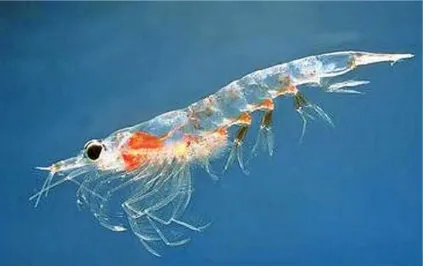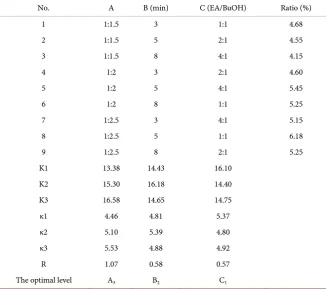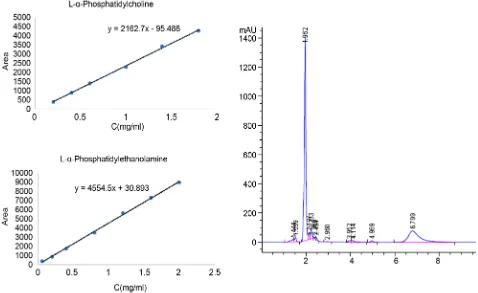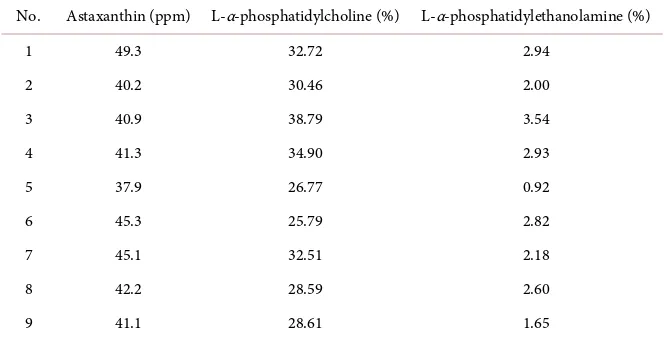http://www.scirp.org/journal/ojms ISSN Online: 2161-7392
ISSN Print: 2161-7384
DOI: 10.4236/ojms.2018.82015 Apr. 25, 2018 293 Open Journal of Marine Science
An Effective Extract Method of Phospholipids
from Antarctic Krill
Euphausea superba
Xiaoqing Tian
1,2, Chengqi Fan
1,3, Zhidong Liu
1,3, Hongliang Huang
1,3, Yanan Lu
1,3*1East China Sea Fisheries Research Institute, Chinese Academy of Fishery Sciences, Shanghai, China 2Key Laboratory of East China Sea Fishery Resources Exploitation, Ministry of Agriculture, Shanghai, China 3Key Laboratory of Oceanic and Polar Fisheries, Ministry of Agriculture, Shanghai, China
Abstract
Phospholipids are one of the major bioactive ingredients of Antarctic krill Euphausea superba. A feasible and effective extraction method of Antarctic krill oil was investigated and modified by orthogonal test which the ratio of solid to liquid was 1:2.5, extraction time was 5 min, ratio of ethyl acetate (EA) and n-butanol (BuOH) was 1:1. With this method, the extract of krill oil has a higher phospholipids content of 27.7% - 42.3%, together with total oil yields of 4.15% - 6.18%.
Keywords
Phospholipids, Antarctic Krill, Euphausea superba, Extraction
1. Introduction
Phospholipids are not only a kind of important bioactive ingredients, but also essential nutrients in the metabolism of organisms. They were used in food, medicine, and industry widely [1] [2] [3]. At present, there were many prepara-tion and purificaprepara-tion methods of phospholipids, such as solvent extracprepara-tion, su-percritical fluid extraction, and column chromatography, as well as analytic me-thods including thin layer chromatography (TLC), high performance liquid chromatography (HPLC), and nuclear magnetic resonance (NMR) [4]. Although the advanced phospholipid production technology has been applied in Europe, America, Japan and some other countries, it is still not popular in China.
According to the abundance phospholipids, Euphausea superba (Figure 1), one major species of Antarctic krill, is a biological enrichment library of phos-pholipids [3]. The main components of the phosphos-pholipids in Antarctic krill are phosphatidyl choline (PC), phosphatidyl ethanolamine (PE), phosphatidyl How to cite this paper: Tian, X.Q., Fan,
C.Q., Liu, Z.D., Huang, H.I. and Lu, Y.N. (2018) An Effective Extract Method of Phospholipids from Antarctic Krill Eu-phausea superba. Open Journal of Marine Science, 8, 293-299.
https://doi.org/10.4236/ojms.2018.82015
Received: February 8, 2018 Accepted: April 22, 2018 Published: April 25, 2018
Copyright © 2018 by authors and Scientific Research Publishing Inc. This work is licensed under the Creative Commons Attribution International License (CC BY 4.0).
http://creativecommons.org/licenses/by/4.0/
DOI: 10.4236/ojms.2018.82015 294 Open Journal of Marine Science
Figure 1. The picture of E. superba.
inositol (PI) and so on [5].
In our continuous investigation on feasible and effective extraction method of Antarctic krill oil, an improved solvent extraction and HPLC were used for ex-traction and detection of the phospholipid from E. superba. The high content phospholipid was therefore obtained.
2. Experimental Section
2.1. General Procedures
Homogenizer (DJ126-DEG1) was offered by Guangdong Midea boutique elec-trical appliance manufacturing co., LTD. Centrifugal machine(KUBOTA 7780) was obtained from Beijing dongxuntiandi medical instrument co. LTD. Agilent 1260 HPLC was used with the column of Atlantis HILIC Silica (4.6 × 150 mm, 5 µm). The ultraviolet spectrophotometer (752N) was purchased from Shanghai Precision and Scientific Instrument Corporation. L-α-phosphatidylcholine (P3556, ≥99%) and L-α-phosphatidylethanolamine (P7943, ≥97%) were ob-tained from Sigma. Astaxanthin was obob-tained from Dr. Ehrenstorfer GmbH. Methanol, acetonitrile and formic acid were chromatographic grade and ob-tained from J. C. Baker. Other reagents were analytical grade and obob-tained from Sinopharm chemical reagent Shanghai co., LTD.
2.2. Biological Source
E. superb were collected from the 30th Chinese Antarctic scientific expedition, and was identified by Prof. Hong-Liang Huang. The samples were flushed with plenty of water and then kept frozen at −18˚C before use.
2.3. Extraction
DOI: 10.4236/ojms.2018.82015 295 Open Journal of Marine Science
Table 1. Factors and levels of orthogonal test.
Factor level
1 2 3
Ratio of solid to liquid (A) 1:1.5 1:2 1:2.5
Extraction time (B)/min 3 5 8
Ratio of solvent (C) 1:1 2:1 4:1
The samples of E. superba were thus divided into 9 groups, and each group was 400 g. Every group was repeatedly extracted in homogenizer with ethyl ace-tate/n-butanol mixed solvent for 3 times at room temperature. Then the super-natants were combined and the solvent was removed in a rotary evaporator at 50˚C, then the fat-soluble extracts, namely krill oils, were obtained and weighed. The yields were calculated as in
( )
( )
Yields=weight of extract g wet weight of E superba. g (1)
2.4. HPLC Analysis of Phospholipids
The standard solutions of L-α-phosphatidylethanolamine and
L-α-phosphatidylcho-line in methanol were made up in two series of concentra-tions (0.2, 0.4, 0.6, 1.0, 1.4, 1.8 mg/mL and 0.06, 0.2, 0.4, 0.8, 1.2, 1.6, 2.0 mg/mL), respectively. Krill oil samples (2.0 mg) were dissolved in methanol to 1.0 mg/mL concentration, respectively. Each reference and sample solutions was filtrated with 0.45 µm filter before injection to HPLC. The mobile phase was acetonitrile/ethanol/water containing 1% acetic acid (V:V:V = 30:69:1), with flow rate of 1.0 mL/min. The detection wavelength was 206 nm. The column temperature was room temperature and the injection volume was 10 uL.
2.5. Analysis of Astaxanthin
Astaxanthin standard (0.12 mg) was dissolved with chloroform and made up as 10.0 mL parent solution. Then it was gradually diluted to give a series of solu-tions of 0.12, 0.6, 1.2, 6, 12 µg/ml. Krill oil samples (20 mg) which was got from orthogonal test were dissolved in chloroform with concentration of 2 mg/mL. Each solution was tested in UV spectrophotometer under 478 nm with chloro-form as blank control.
All statistical analyses were executed by using the Origin 9.1 software.
3. Results and Discussion
3.1. The Yields of Krill Oils
DOI: 10.4236/ojms.2018.82015 296 Open Journal of Marine Science
Table 2. The extraction yield of fat soluble ingredients from E. superba.
No. A B (min) C (EA/BuOH) Ratio (%)
1 1:1.5 3 1:1 4.68
2 1:1.5 5 2:1 4.55
3 1:1.5 8 4:1 4.15
4 1:2 3 2:1 4.60
5 1:2 5 4:1 5.45
6 1:2 8 1:1 5.25
7 1:2.5 3 4:1 5.15
8 1:2.5 5 1:1 6.18
9 1:2.5 8 2:1 5.25
K1 13.38 14.43 16.10
K2 15.30 16.18 14.40
K3 16.58 14.65 14.75
κ1 4.46 4.81 5.37
κ2 5.10 5.39 4.80
κ3 5.53 4.88 4.92
R 1.07 0.58 0.57
The optimal level A3 B2 C1
with Sun Lei’s result [9]. Secondly, among all the three factors, ratio of solid to liquid was the most important factor which affected extraction yields because its value, the maximum range, was 1.07. The higher the ratio was, the larger the surface area of the solvent contact was. The influences of extraction time and solvent ratio were approximate, and were lower than that of solvent amount. However, they could not be neglected. At last, according to uniform design me-thod, the best combination of experimental condition was A3B2C1, which meant the ratio of solid to liquid 1:2.5, extraction time 5 min, ratio of EA/BuOH 1:1, which was amazing the same to group 8th.
3.2. The Contents of Phospholipids and Astaxanthin in Krill
Oil Samples
Standard curves (Figure 2) were constructed for peak areas and concentrations of standards L-α-phosphatidylethanolamine (tR 3.9) and L-α-phosphatidylcholine (tR 6.7), respectively. A good linear correlation was observed in the concentra-tion range of 0.2 - 1.8 mg/mL of L-α-phosphatidylcholine, and its equation of calibration curve was Y = 2462.7X − 95.488 (R2 = 0.9987). While for L-α-phosphatidylethanolamine, linear correlation was observed between con-centrations of 0.06 and 2.0 mg/mL, with the equation of calibration curve Y = 4554.5X − 30.893 (R2 = 0.9989).
DOI: 10.4236/ojms.2018.82015 297 Open Journal of Marine Science
Figure 2. Standard curves of L-α-phosphatidylethanolamine and L-α-phosphatidylcholine, and HPLC of krill oils.
and L-α-phosphatidylethanolamine (Table 3), which can be separated from other impurities completely in orthogonal sample (Figure 1). The contents of L-α-phosphatidylcholine and L-α-phosphatidylethanolamine in the krill oils ac-counted for 25.79% - 38.79%, 0.92% - 3.54%, respectively. The results were close to the results of Bjørn Winther [10]. It should be mentioned that L-α-phosphatidylcholine was more than 90% of the total phospholipids.
The contents of astaxanthin in these samples were also determined by UV spectrophotometer. Standard curves were constructed for absorbance and con-centrations of standard astaxanthin. A good linear correlation was observed in the concentration range of 0.12 - 12 µg/mL. The equation of calibration curve was A = 0.1710C + 0.0601 (R2 = 0.9956). The contents of astaxanthin in these krill oil samples accounted for 37.9 ~ 49.3 ppm. Astaxanthin was a kind of natu-ral pigment in the E. superba, which was easier to be esterified. The average content is about 180 ppm (132 - 250 ppm) [11]. These experiment results were less thanthe average range. Therefore, to raise the contents of astaxanthin in ex-traction of E. superba will be the following research emphasis.
DOI: 10.4236/ojms.2018.82015 298 Open Journal of Marine Science
Table 3. The contents of astaxanthin and phospholipid of the krill oil samples.
No. Astaxanthin (ppm) L-α-phosphatidylcholine (%) L-α-phosphatidylethanolamine (%)
1 49.3 32.72 2.94
2 40.2 30.46 2.00
3 40.9 38.79 3.54
4 41.3 34.90 2.93
5 37.9 26.77 0.92
6 45.3 25.79 2.82
7 45.1 32.51 2.18
8 42.2 28.59 2.60
9 41.1 28.61 1.65
Acknowledgements
Financial support of Central Public-interest Scientific Institution Basal Research Fund, CAFS (No. 2016HY-ZD0903) was greatly appreciated.
References
[1] Niu, Z.A. (1999) Soybean Lecithin at Home and Abroad Market and Development.
Cereals & Oils, 1, 33-37.
[2] Zhao, X.-P., Wang, S., Hao, P.-F., Miao, J.-K., Liu, X.-F., Gao, H., Zhao, X.-Y. and Leng, K.-L. (2016) Optimization of Preparation of the Antarctic Krill Phospholipid Ginsenoside Phospholipid-Complex by Response Surface Methodology. Chinese Journal of Marine Drugs, 35, 72-80.
[3] An, H., Song, W.M. and Zhang, H.B. (2006) Phospholipid Chemistry and Applica-tion Technology. Chinese Metrology Press, Beijing.
[4] Ali-Nehari, A. and Chun, B.S. (2011) Characterization of Purified Phospholipids from Krill (Euphausiasuperba) Residues Deoiled by Supercritical Carbon Dioxide.
Korean Journal of Chemical Engineering, 29, 918-924.
https://doi.org/10.1007/s11814-011-0273-4
[5] Yan, Y.-Y., Zhang, K.-Y., Huang, J.-H., Liu, L.-F. and Wang, X.-G. (2012) Research Advance in Separation, Purification and Determination of Phospholipids. China Oils and Fats, 37, 61-65
[6] Wang, H.-R., Kong, X.-Z. and Hua, Y.-F. (2012) Extraction and Analysis of Resi-dual Lipids in Soybeanmeal. China Oils and Fats, 37, 84-87.
[7] Zhang, J.-T., Lu, Y.-N., Yang, Q., Ma, L.-Y., Fan, C.-Q. and Tian, X.-Q. (2015) On the Extraction of Liposoluble Components from Aplidiumconstellatum. Marine Fi-sheries, 37, 264-269
[8] Yang, C.-L., Shi, Y.-T. and Tang, Y.-Q. (2017) Orthogonal Test and Regression Analysis of the Strain on Silty Soil in Shanghai under Metro Loading. Environmen-tal Earth Sciences, 75, 506
[9] Sun, L., Zhou, D.-Q. and Sheng, X.-F. (2008) Nutrition and Safety Evaluation of Antarctic Krill. Marine Fisheries Research, 29, 57-64.
DOI: 10.4236/ojms.2018.82015 299 Open Journal of Marine Science https://doi.org/10.1007/s11745-010-3472-6



